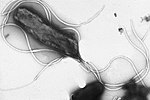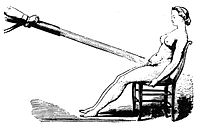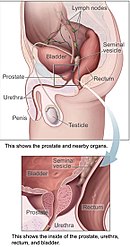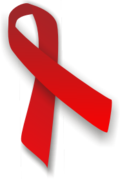Portal:Medicine/Selected Article Archive (2006)
December 23, 2006 - December 30: Female hysteria
[edit]Female hysteria was an incorrectly diagnosed medical condition in western medicine that is not currently acknowledged by the medical community. It was a popular diagnosis in the Victorian era for a wide array of symptoms including faintness, nervousness, insomnia, fluid retention, heaviness in abdomen, muscle spasm, shortness of breath, irritability, loss of appetite for food or sex, and a "tendency to cause trouble".
Patients diagnosed with female hysteria would undergo "pelvic massage" — manual stimulation of the woman's genitals by the doctor to "hysterical paroxysm", which is now recognized as orgasm.
(More...)
December 16, 2006 - December 23: H5N1
[edit]Influenza A virus subtype H5N1, also known as A(H5N1) or H5N1, is a subtype of the Influenza A virus that can cause illness in humans and many other animal species. A bird-adapted strain of H5N1, called HPAI A(H5N1) for "highly pathogenic avian influenza virus of type A of subtype H5N1", is the causative agent of H5N1 flu, commonly known as "avian influenza" or "bird flu". It is endemic in many bird populations, especially in Southeast Asia. One strain of HPAI A(H5N1) is spreading globally after first appearing in Asia. It is epizootic (an epidemic in nonhumans) and panzootic (affecting animals of many species, especially over a wide area), killing tens of millions of birds and spurring the culling of hundreds of millions of others to stem its spread. Most mentions of "bird flu" and H5N1 in the media refer to this strain.
(More...)
December 9, 2006 - December 16: Forensic facial reconstruction
[edit]Forensic facial reconstruction (or forensic facial approximation) is the process of recreating the face of an unidentified individual from their skeletal remains through an amalgamation of artistry, forensic science, anthropology, osteology, and anatomy. It is easily the most subjective - as well as one of the most controversial - techniques in the field of forensic anthropology. Despite this controversy, facial reconstruction has proved successful frequently enough that research and methodological developments continue to be advanced.
In addition to remains involved in criminal investigations, facial reconstructions are created for remains believed to be of historical value and for remains of prehistoric hominids and humans. (More...)
December 3, 2006 - December 9: HIV/AIDS in Brazil
[edit]The first AIDS case was identified in Brazil in 1982. Infection rates climbed exponentially throughout the 1980s, and in 1990 the World Bank famously predicted 1,200,000 cases by 2000, approximately double the actual number reported by the Brazilian Ministry of Health and most international organizations.
The Brazilian experience is frequently cited as a model for other developing countries facing the AIDS epidemic, including the internationally controversial policies of the Brazilian government such as the universal provision of antiretroviral drugs (ARVs), progressive social policies toward risk groups, and collaboration with non-governmental organizations. (More...)
November 26, 2006 - December 3: Baby Gender Mentor
[edit]The Baby Gender Mentor test is a blood test designed to determine if a pregnant mother is carrying a boy or a girl. The test is made by Acu-Gen Biolab, Inc, a biotech company in Lowell, Massachusetts, in the United States and is marketed to detect the gender of a fetus as early as five weeks after conception. An estimated 50-70% of expectant parents would like to know the gender of their child ahead of delivering the baby. Some parents would like to know this information early in order to get a head start on shopping for baby clothes or decorating the nursery. Others have cited an interest in preparing themselves or the baby's siblings for gender-specific issues.
The test has been the center of several controversies. Some customers and scientists are questioning the accuracy of the test. A class-action lawsuit has been filed against Acu-Gen and a major supplier of the test is under criminal investigation. Concerns have also been raised by bioethicists that use of the test could lead to unethical practices such as gender selection. There have also been anecdotal reports of Acu-Gen making additional claims for use of the test in ways that are not described in the product packaging or on the company's website. (More...)
November 19, 2006 - November 26: Rabies
[edit]Rabies (Latin, rabies, "madness, rage, fury") is a viral zoonotic disease that causes acute encephalitis in animals. In non-vaccinated humans, rabies is almost invariably fatal after neurological symptoms have developed, but prompt post-exposure vaccination may prevent the virus from progressing.
Cats, dogs, ferrets, raccoons, skunks, foxes, wolves, coyotes, bears, bats, and horses can become rabid. Squirrels, chipmunks, other rodents (except beavers), and rabbits are very seldom infected. Rabies may also be present in a so-called "paralytic" form, rendering the victim abnormally quiet and withdrawn.
The virus is usually present in the saliva of a symptomatic rabid animal; the route of infection is nearly always by a bite, and causes the victim to be exceptionally aggressive. Transmission has occurred via an aerosol through mucous membranes; transmission in this form may have happened in people exploring caves populated by rabid bats. Transmission between humans is extremely rare, though it can happen through transplant surgery (see below for recent cases), or even more rarely through bites or kisses.(More...)
November 12, 2006 - November 19: Osteonecrosis of the jaw
[edit]Osteonecrosis of the jaw (ONj) is a severe bone disease that affects the jaws, including the maxilla and the mandible. Jaw bone (osteo-) damage and death (-necrosis) occurs as a result of reduced local blood supply (ischaemia). The condition is thus included in the general category of ischaemic or avascular osteonecrosis (literally "dead bone from poor blood flow.").
Various forms of ONj have been described over the last 160 years, and a number of causes have been suggested in the literature. In recent years, an increased incidence of ONj has been associated with the use of high dosages of bisphosphonates, required by some cancer treatment regimens, especially when the patient undergoes subsequent dental procedures. The possible risk from lower oral doses of bisphosphonates, taken by patients to prevent or treat osteoporosis, remains uncertain. (More...)
November 5, 2006 - November 12: Black Death
[edit]The Black Death, also known as the Black Plague, was a devastating pandemic that first struck Europe in the mid-late-14th century (1347–1351), killing between a third and two-thirds of Europe's population. Almost simultaneous epidemics occurred across large portions of Asia and the Middle East during the same period, indicating that the European outbreak was actually part of a multi-regional pandemic. Including Middle Eastern lands, India and China, the Black Death killed at least 75 million people.
The Black Death had a drastic effect on Europe's population, irrevocably changing Europe's social structure. It was a serious blow to the Roman Catholic Church, Europe's predominant religious institution at the time, and resulted in widespread persecution of minorities such as Jews, Muslims, foreigners, beggars and lepers. The uncertainty of daily survival created a general mood of morbidity influencing people to live for the moment, as illustrated by Giovanni Boccaccio in The Decameron (1353). (More...)
October 28, 2006 - November 5: Stem cells
[edit]Stem cells in humans are primal undifferentiated cells that retain the ability to produce an identical copy of themselves when they divide (clone) and differentiate into other cell types. In higher animals this function is the defining property of the deleted cells. Stem cells have the ability to act as a repair system for the body, because they can divide and differentiate, replenishing other cells as long as the host organism is alive.
Medical researchers believe stem cell research has the potential to change the face of human disease by being used to repair specific tissues or to grow organs. Yet there is general agreement that, "significant technical hurdles remain that will only be overcome through years of intensive research.". Current evidence indicates that some stem cells are involved in assisting cancer's proliferation, or worse yet, some stem cells act as cancer stem cells (CSC). (More...)
October 22, 2006 - October 28: Down syndrome
[edit]Down syndrome or trisomy 21 (British Down's syndrome) is a genetic condition resulting from the presence of all or part of an extra 21st chromosome. Down syndrome is characterized by a combination of major and minor abnormalities of body structure and function. Among features present in nearly all cases are impairment of learning and physical growth, and a recognizable facial appearance usually identified at birth. It is named after John Langdon Down, the British doctor who first described it in 1866.
Individuals with Down syndrome have lower than average cognitive ability, normally ranging from mild to moderate retardation. Some individuals may have average intelligence overall, but will generally have some amount of developmental disability, such as a tendency toward concrete thinking or naïveté. There is also a small number of individuals with Down syndrome with severe to profound mental retardation. The incidence of Down syndrome is estimated at 1 per 800 to 1 per 1000 births.(More...)
October 15, 2006 - October 21: Prostate cancer
[edit]Prostate cancer is a disease in which cancer develops in the prostate, a gland in the male reproductive system. Cancer cells may spread (metastasize) from the prostate to other parts of the body, especially the bones and lymph nodes. Prostate cancer may cause pain, difficulty in urinating, erectile dysfunction and other symptoms.
Prostate cancer develops most frequently in men over fifty. This cancer can only occur in men; the prostate is exclusively of the male reproductive tract. It is the second most common type of cancer in men in the United States, where it is responsible for more male deaths than any other cancer except lung cancer. However, many men who develop prostate cancer never have symptoms, undergo no therapy, and eventually die of other causes. Many factors, including genetics and diet, have been implicated in the development of prostate cancer. (More...)
October 8, 2006 - October 14: Acute myeloid leukemia
[edit]Acute myeloid leukemia (AML), also known as acute myelogenous leukemia, is a cancer of the myeloid line of white blood cells, characterized by the rapid proliferation of abnormal cells which accumulate in the bone marrow and interfere with the production of normal blood cells. AML is the most common acute leukemia affecting adults, and its incidence increases with age. While AML is a relatively rare disease overall, accounting for approximately 1.2% of cancer deaths in the United States, its incidence is expected to increase as the population ages.
The symptoms of AML are caused by replacement of normal bone marrow with leukemic cells, resulting in a drop in red blood cells, platelets, and normal white blood cells. While a number of risk factors for AML have been elucidated, the specific cause of AML remains unclear. As an acute leukemia, AML progresses rapidly and is typically fatal in weeks to months if untreated.
Acute myeloid leukemia is a potentially curable disease; however, only a minority of patients are cured with current therapy. AML is treated initially with chemotherapy aimed at inducing a remission; some patients may go on to receive a hematopoietic stem cell transplant. (More...)
October 1, 2006 - October 7: Yellow fever
[edit]Yellow fever (also called yellow jack, black vomit or vomito negro in Spanish, or sometimes American Plague) is an acute viral disease. It is an important cause of hemorrhagic illness in many African and South American countries despite existence of an effective vaccine. The yellow in the disease name refers to the jaundice that affects some patients.
Yellow fever has been a source of several devastating epidemics. During one of Napoleon's campaigns to Haiti in 1802, the troops were attacked by yellow fever. More than half of the army perished due to the disease. Outbreaks followed by thousands of fatalities occurred periodically in other Western Hemisphere locations until research which included human volunteers (some of whom died) led to an understanding of the method of transmission to humans (primarily by mosquitos) and development of a vaccine and other preventative efforts in the early 20th century. (More...)
September 25, 2006 - October 1: Tourette syndrome
[edit]Tourette syndrome is an inherited neurological disorder with onset in childhood, characterized by the presence of multiple physical (motor) tics and at least one vocal (phonic) tic; these tics usually wax and wane. Tourette's is defined as part of a spectrum of tic disorders, which includes transient and chronic tics.
Tourette's was once considered a rare and bizarre syndrome, most often associated with the exclamation of obscene words or socially inappropriate and derogatory remarks (coprolalia). However, this symptom is present in fewer than 15% of people with Tourette's. It is no longer considered a rare condition, but it may not always be correctly identified because of the wide range of severity, with most cases classified as mild. Genetic and environmental factors each play a role in the etiology of Tourette's, but the exact causes are unknown. (More...)
September 18, 2006 - September 24: Barbara McClintock
[edit]Barbara McClintock (June 16, 1902 – September 2, 1992) was a pioneering American scientist and one of the world's most distinguished cytogeneticists. McClintock received her PhD in botany from Cornell University in 1927, where she was a leader in the development of maize cytogenetics. The field remained the focus of her research for the rest of her career. From the late 1920s, McClintock studied chromosomes and how they change during reproduction in maize. Her work was groundbreaking: she developed the technique to visualize maize chromosomes and used microscopic analysis to demonstrate many fundamental genetic ideas, including genetic recombination by crossing-over during meiosis—a mechanism by which chromosomes exchange information. She produced the first genetic map for maize, linking regions of the chromosome with physical traits, and she demonstrated the role of the telomere and centromere, regions of the chromosome that are important in the conservation of genetic information. She was recognized amongst the best in the field, awarded prestigious fellowships and elected a member of the National Academy of Sciences in 1944. (More...)
September 11, 2006 - September 17: Lesch-Nyhan syndrome
[edit]Lesch-Nyhan syndrome (LNS) is a rare, inherited disorder caused by a deficiency of the enzyme hypoxanthine-guanine phosphoribosyltransferase (HPRT). LNS is an X-linked recessive disease: the gene is carried by the mother and passed on to her son. LNS is present at birth in baby boys. Patients have severe mental and physical problems throughout life. The lack of HPRT causes a build-up of uric acid in all body fluids, and leads to problems such as severe gout, poor muscle control, and moderate mental retardation, which appear in the first year of life. A striking feature of LNS is self-mutilating behaviors, characterized by lip and finger biting, that begin in the second year of life. Abnormally high uric acid levels can cause sodium urate crystals to form in the joints, kidneys, central nervous system and other tissues of the body, leading to gout-like swelling in the joints and severe kidney problems. Neurological symptoms include facial grimacing, involuntary writhing, and repetitive movements of the arms and legs similar to those seen in Huntington's disease. The direct cause of the neurological abnormalities remains unknown. Because a lack of HPRT causes the body to poorly utilize vitamin B12, some boys may develop a rare disorder called megaloblastic anemia. (More...)
September 4, 2006 - September 10: DNA repair
[edit]DNA repair refers to a collection of processes by which a cell identifies and corrects damage to the DNA molecules that encode its genome. In human cells, both normal metabolic activities and environmental factors such as UV light can cause DNA damage, resulting in as many as 1 million individual molecular lesions per cell per day. Many of these lesions cause structural damage to the DNA molecule and can alter or eliminate the cell's ability to transcribe the gene that the affected DNA encodes. Other lesions induce potentially harmful mutations in the cell's genome, which will affect the survival of its daughter cells after it undergoes mitosis. Consequently, the DNA repair process must be constantly active so it can respond rapidly to any damage in the DNA structure.
The DNA repair ability of a cell is vital to the integrity of its genome and thus to its normal functioning and that of the organism. Many genes that were initially shown to influence lifespan have turned out to be involved in DNA damage repair and protection. Failure to correct molecular lesions in cells that form gametes can introduce mutations into the genomes of the offspring and thus influence the rate of evolution. (More...)
August 28, 2006 - September 3: Multiple sclerosis
[edit]Multiple sclerosis (abbreviated MS, also known as disseminated sclerosis) is a chronic, inflammatory disease that affects the central nervous system (CNS). MS can cause a variety of symptoms, including changes in sensation, visual problems, muscle weakness, depression, difficulties with coordination and speech, and pain. Although many patients lead full and rewarding lives, MS can cause impaired mobility and disability in the more severe cases.
Multiple sclerosis affects neurons, the cells of the brain and spinal cord that carry information, create thought and perception and allow the brain to control the body. Surrounding and protecting some of these neurons is a fatty layer known as the myelin sheath, which helps neurons carry electrical signals. MS causes gradual destruction of myelin (demyelination) and transection of neuron axons in patches throughout the brain and spinal cord, causing various symptoms depending upon which signals are interrupted. The name multiple sclerosis refers to the multiple scars (or scleroses) on the myelin sheaths. It is thought that MS results from attacks by an individual's immune system on the nervous system and is therefore categorized as an autoimmune disease.
(More...)
August 21, 2006 - August 27: AIDS
[edit]Acquired immunodeficiency syndrome or Acquired immune deficiency syndrome (AIDS or Aids) is a collection of symptoms and infections in humans resulting from the specific damage to the immune system caused by infection with the human immunodeficiency virus (HIV). The late stage of the condition leaves individuals prone to opportunistic infections and tumors. Although treatments for AIDS and HIV exist to slow the virus's progression, there is no known cure. HIV is transmitted through direct contact of a mucous membrane or the bloodstream with a bodily fluid containing HIV, such as blood, semen, vaginal fluid, preseminal fluid, and breast milk. This transmission can come in the form of anal, vaginal or oral sex, blood transfusion, contaminated needles, exchange between mother and baby during pregnancy, childbirth, or breastfeeding, or other exposure to one of the above bodily fluids.
Most researchers believe that HIV originated in sub-Saharan Africa during the twentieth century; it is now a pandemic, with an estimated 38.6 million people now living with the disease worldwide.
(More...)
August 14, 2006 - August 20: Paracetamol
[edit]Paracetamol (INN) (IPA: [pærəˈsitəmɒl, -moʊl, -ˈsɛtə-]) or acetaminophen (USAN) (brand names Tylenol® in US and Panadol® in UK), is a common analgesic and antipyretic drug that is used for the relief of fever, headaches, and other minor aches and pains. Paracetamol is also useful in managing more severe pain, allowing lower dosages of additional NSAID or opioid analgesics to be used, so minimising overall side-effects. It is a major ingredient in numerous cold and flu medications and many prescription analgesics. It is remarkably safe in recommended doses, but because of its wide availability, deliberate or accidental overdoses are fairly common.
The words acetaminophen and paracetamol both come from the chemical names for the compound: N-acetyl-para-aminophenol and para-acetyl-amino-phenol. In some contexts, it is shortened to apap, for N-acetyl-para-amino-phenol. (More...)
August 7, 2006 - August 13: Tooth enamel
[edit]Tooth enamel is the hardest and most highly mineralized substance of the body, and with dentin, cementum, and dental pulp is one of the four major parts of the tooth. It is the normally visible dental tissue of a tooth and must be supported by underlying dentin. Ninety-six per cent of enamel consists of minerals, with water and organic material composing the rest. The normal color of enamel varies from light yellow to grayish white. At the edges of teeth where there is no dentin underlying the enamel, the color sometimes has a slightly blue tone. Since enamel is semitranslucent, the color of dentin and any restorative dental material underneath the enamel strongly affects the appearance of a tooth. Enamel varies in thickness over the surface of the tooth and is often thickest at the cusp, up to 2.5 mm, and thinnest at its border, which is seen clinically as the cementoenamel junction (CEJ).
Enamel's primary mineral is hydroxyapatite, which is a crystalline calcium phosphate. The large amount of minerals in enamel accounts not only for its strength but also for its brittleness. Dentin, which is less mineralized and less brittle, compensates for enamel and is necessary as a support. (More...)
July 31, 2006 - August 6: Menstrual cycle
[edit]The menstrual cycle is a recurring cycle of physiological changes in the females of some animal species that is associated with reproductive fertility. Only human beings and the great apes experience a true menstrual cycle. Most placental mammals experience estrus instead. The menstrual cycle is under the control of the reproductive hormone system and is necessary for reproduction. In women, menstrual cycles occur typically on a monthly basis between puberty and menopause.
During the menstrual cycle, the sexually mature female body builds up the lining of the uterus with gradually increasing amounts of estrogen, and when this hormone reaches a critical level, estradiol is produced, and shortly thereafterward there is the stimulation of the ovaries with Follicle Stimulating Hormone, and luteinizing hormone. Follicles begin developing, and within a few days one "matures" into an ovum or egg. The ovary then releases this egg, (or occasionally two, which might result in dizygotic, or non-identical, twins) at the time of ovulation. The lining of the uterus, the endometrium, peaks shortly there afterward in a synchronised fashion. After ovulation, this lining changes to prepare for potential conception and implantation of the fertilized egg to establish a pregnancy. The hormone progesterone rises after ovulation, and peaks shortly thereafter. (More...)
July 24, 2006 - July 30: Tooth development
[edit]Tooth development is the complex process by which teeth form from embryonic cells, grow, and erupt into the mouth. Although many diverse species have teeth, non-human tooth development is largely the same as in humans. For human teeth to have a healthy oral environment, enamel, dentin, cementum, and the periodontium must all develop during appropriate stages of fetal development. Primary (baby) teeth start to form between the sixth and eighth weeks in utero, and permanent teeth begin to form in the twentieth week in utero. If teeth do not start to develop at or near these times, they will not develop at all.
A significant amount of research has focused on determining the processes that initiate tooth development. It is widely accepted that there is a factor within the tissues of the first branchial arch that is necessary for the development of teeth. (More...)
July 17, 2006 - July 23: Pneumonia
[edit]Pneumonia is an illness of the lungs and respiratory system in which the alveoli (microscopic air-filled sacs of the lung responsible for absorbing oxygen from the atmosphere) become inflamed and flooded with fluid. Pneumonia can result from a variety of causes, including infection with bacteria, viruses, fungi, or parasites. Pneumonia may also occur from chemical or physical injury to the lungs, or indirectly due to another medical illness, such as lung cancer or alcohol abuse.
Typical symptoms associated with pneumonia include cough, chest pain, fever, and difficulty breathing. Diagnostic tools include x-rays and examination of the sputum. Treatment depends on the cause of pneumonia; bacterial pneumonia is treated with antibiotics.
Pneumonia is a common illness, occurs in all age groups, and is a leading cause of death among the elderly and people who are chronically ill. Vaccines to prevent certain types of pneumonia are available. The prognosis for an individual depends on the type of pneumonia, the appropriate treatment, any complications, and the person's underlying health. (More...)
July 10, 2006 - July 16: Médecins Sans Frontières
[edit]Médecins Sans Frontières (ⓘ) is a secular humanitarian-aid non-governmental organisation best known for its projects in war-torn regions and developing countries facing endemic disease.
Médecins Sans Frontières was created in 1971 by a small group of French doctors, as an aftermath of the Biaffra secession. The organisation is known to much of the world by its French name or simply as MSF. In many countries (such as the United States), the English-translated name Doctors Without Borders is used instead. (More...)
July 3, 2006 - July 9: Tuberculosis
[edit]Tuberculosis (commonly abbreviated as TB) is an infection caused by the bacterium Mycobacterium tuberculosis, which most commonly affects the lungs (pulmonary TB) but can also affect the central nervous system (meningitis), lymphatic system, circulatory system (Miliary tuberculosis), genitourinary system, bones and joints.
Tuberculosis is one of the most deadly and common major infectious diseases today. As of 2004, 14.6 million people have active TB disease with nine million new cases of the disease and nearly two million deaths, mostly in developing countries. However, developing countries are not the only places with tuberculosis. There is a rising number of people in the developed world who contract tuberculosis because they have compromised immune systems, typically as a result of immunosuppressive drugs or HIV/AIDS. These people are at particular risk of tuberculosis infection and active tuberculosis disease. (More...)
June 26, 2006 - July 2: Keratoconus
[edit]Keratoconus (from Greek: kerato- horn, cornea; and konos cone), is a degenerative non-inflammatory disorder of the eye in which structural changes within the cornea cause it to thin and change to a more conical shape than its normal, gradual curve. Keratoconus can cause substantial distortion of vision, with multiple images, streaking and sensitivity to light all often reported by the patient. Though frequently thought of as a rare condition, keratoconus is the most common dystrophy of the cornea, affecting around one person in a thousand, and it seems to occur equally in all ethnic groups worldwide. It is typically diagnosed in the patient's adolescent years and attains its most severe state in the twenties and thirties. (More...)
June 19, 2006 — June 25: Chagas' disease
[edit]Chagas disease (also called American trypanosomiasis) is a human tropical parasitic disease which occurs in the Americas, particularly in South America. Its pathogenic agent is a flagellate protozoan named Trypanosoma cruzi, which is transmitted to humans and other mammals mostly by hematophagous assassin bugs of the subfamily Triatominae (Family Reduviidae). Those insects are known by numerous common names varying by country, including benchuca, vinchuca, kissing bug, chipo, barbeiro, etcetera. The most common insect species belong to the genera Triatoma, Rhodnius, and Panstrongylus. Other forms of transmission are possible, though, such as ingestion of food contaminated with parasites, blood transfusion and fetal transmission.
Trypanosoma cruzi is a member of the same genus as the infectious agent of African sleeping sickness, but its clinical manifestations, geographical distribution, life cycle and insect vectors are quite different. (More...)
June 12, 2006 — June 18: Cerebellum
[edit]The cerebellum (Latin: "little brain") is a region of the brain that plays an important role in the integration of sensory perception and motor output. Many neural pathways link the cerebellum with the motor cortex—which sends information to the muscles causing them to move—and the spinocerebellar tract—which provides feedback on the position of the body in space (proprioception). The cerebellum integrates these pathways, using the constant feedback on body position to fine-tune motor movements.
Because of this 'updating' function of the cerebellum, lesions within it are not so debilitating as to cause paralysis, but rather present as feedback deficits resulting in disorders in fine movement, equilibrium, posture, and motor learning. Initial observations by physiologists during the 18th century indicated that patients with cerebellar damage show problems with motor coordination and movement. Research into cerebellar function during the early to mid 19th century was done via lesion and ablation studies in animals. Research physiologists noted that such lesions led to animals with strange movements, awkward gait, and muscular weakness. These observations and studies led to the conclusion that the cerebellum was a motor control structure. However, modern research shows that the cerebellum has a broader role in a number of key cognitive functions, including attention and the processing of language, music, and other sensory temporal stimuli. (More...)
June 6, 2006 — June 11: Helicobacter pylori
[edit]
Helicobacter pylori is a bacterium that infects the mucus lining of the human stomach. Many peptic ulcers and some types of gastritis are caused by H. pylori infection, although most humans who are infected will never develop symptoms. This bacterium lives in the human stomach exclusively and is the only known organism that can thrive in that highly acidic environment. It is helix-shaped (hence the name helicobacter) and can literally screw itself into the stomach lining to colonize.
The bacterium was rediscovered in 1982 by two Australian scientists Robin Warren and Barry Marshall; they isolated the organisms from mucosal specimens from human stomachs and were the first to successfully culture them. In their original paper, Warren and Marshall contended that most stomach ulcers and gastritis were caused by colonization with this bacterium, not by stress or spicy food as had been assumed before. Read more...
May 24, 2006 — June 6: Asthma
[edit]
Asthma is a disease of the human respiratory system where the airways narrow, often in response to a "trigger" such as exposure to an allergen, cold air, exercise, or emotional stress. This narrowing causes symptoms such as wheezing, shortness of breath, chest tightness, and coughing, which respond to bronchodilators. Between episodes, most patients feel fine.
The disorder is a chronic (reoccurring) inflammatory condition in which the airways develop increased responsiveness to various stimuli, characterized by bronchial hyper-responsiveness, inflammation, increased mucus production, and intermittent airway obstruction. The symptoms of asthma, which can range from mild to life-threatening, can usually be controlled with a combination of drugs and lifestyle changes.
The word asthma is derived from the Greek aazein, meaning "sharp breath." The word first appears in Homer's Iliad. Hippocrates was the first to use it in reference to the medical condition. Hippocrates thought that the spasms associated with asthma were more likely to occur in tailors, anglers, and metalworkers. Six centuries later, Galen wrote much about asthma, noting that it was caused by partial or complete bronchial obstruction. Moses Maimonides, an influential medieval rabbi, philosopher, and physician, wrote a treatise on asthma, describing its prevention, diagnosis, and treatment.Read more...






















